#Japanese Heavy Cruiser
Explore tagged Tumblr posts
Text

Japanese heavy cruiser Nachi on a vintage postcard
#postcard#ansichtskarte#briefkaart#photography#carte postale#vintage#japanese#postkarte#photo#historic#postkaart#cruiser#ephemera#nachi#sepia#heavy#tarjeta#postal
15 notes
·
View notes
Text

Myoko Class cruiser, Nagara(?) in background.
11 notes
·
View notes
Photo

Croiseur lourd USS Augusta (CA-31) ancré au large du district de Pudong pendant les combats de la bataille de Shanghai – Guerre sino-japonaise – Shanghai – Chine – Août 1937
©United States Navy Naval History and Heritage Command - NH 78379
#WWII#Guerre Sino-japonaise#Second Sino-Japanese War#Bataille de Shanghai#Battle of Shanghai#Marine américaine#US Navy#Marine de guerre#Navy#Marine militaire#Military navy#Croiseur#Cruiser#Croiseur lourd#Heavy cruiser#Classe Northampton#Northampton class#USS Augusta (CA-31)#USS Augusta#CA-31#Pudong#Shanghai#Chine#China#08/1937#1937
13 notes
·
View notes
Text
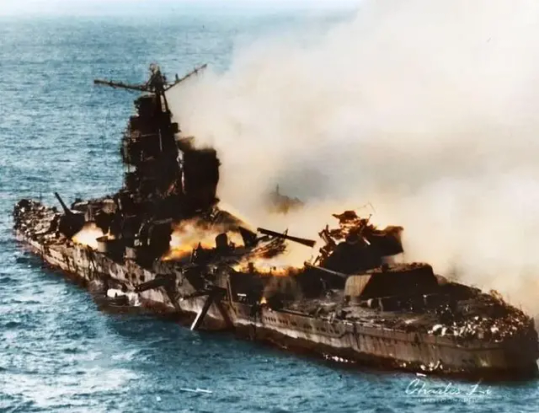
Japanese heavy cruiser Mikuma sinking during the Battle of Midway after being struck by multiple American aircraft, 6 June 1942
117 notes
·
View notes
Text

This Day in History: Navy Cross Recipient George Rentz
On this day in 1942, a Navy chaplain engages in an action that would earn him the Navy Cross. George S. Rentz is the only Navy Chaplain to receive the Cross during World War II.
Chaplain Rentz had already served in World War I and was pushing 60 years old by the time the Japanese attacked Pearl Harbor in December 1941. Nevertheless, he was soon in the thick of things, serving aboard the heavy cruiser USS Houston.
FULL STORY: https://www.taraross.com/post/tdih-george-rentz-cross
13 notes
·
View notes
Text

The Japanese battleship Haruna conducting trials following her major reconstruction in 1934.
During her reconstruction, Haruna took on enough additional weaponry, armor, and other equipment that it required adding blisters to her hull (improving her stability while also increasing her protection against underwater threats). This led to an increase in her displacement by roughly 5,000 long tons. Her standard displacement grew from 27,500 long tons to 32,200 long tons. Her new full load displacement grew to roughly 36,600 long tons.
Despite the increase in tonnage and the widening of the beam from 92' (28m) to a new maximum of 101' 8" (31m), the speed of Haruna actually increased. This was due to a new powerplant, her sixteen coal-fired boilers (the result of a 1920s modernization that replaced her original thirty-six boilers) being replaced by eleven brand-new oil-fired models. This doubled her power from 64,000shp (her original output) to a new maximum of 136,000shp. The increase in power was also helped by grafting a new stern section to the hull, increasing her length by 26' (7.8m) and helping maintain her length-to-beam ratio even with the new blisters. This was enough to permit a new maximum speed of just over 30 knots.
Now, a lot of people would say this was all for naught, considering the armor was still relatively light by battleship standards. This certainly showed itself to be a problem when Kirishima was destroyed by American battleships. On the other hand, the Kongo class were far more likely to meet enemy destroyers or cruisers in combat. In this regard, the armor was sufficient.
I would go so far to say that the Kongo class were the most useful battleships in the Japanese Navy during World War 2. Their speed made them far more flexible and able to undertake a greater variety of roles.
The only major weakness of the rebuilt Kongo class was their lack of a truly modern anti-aircraft weapon system. Of course, this was a problem that affected Japan as a whole. Had the Kongo class had access to some improved anti-aircraft weapons, perhaps the 100mm heavy anti-aircraft weapons, they would have proved to be even better escorts in fleet actions.
21 notes
·
View notes
Text
PR6 - Kearsarge


Ok, don't laugh.
I can't find any good 'accurate' angel iconography right now - at least nothing that matches what I see in Kearsarge, but her design is very angelic. In the literal sense, unlike Plymmouth and Brest; who have divine elements in their design, but are not angels. No, Kearsarge is something else. Not angelic, but a proper angel.
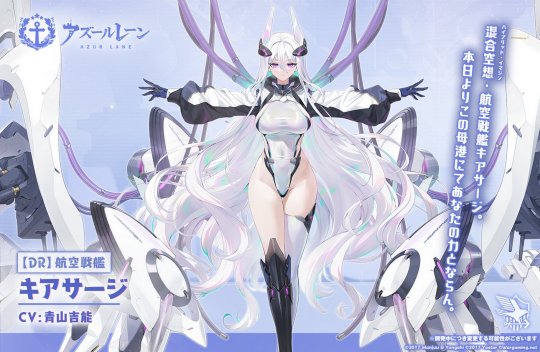
However, she is not a normal angel. No, far from it.
According to the lore (that I can remember right now, meaning I'm probably getting something wrong), Priority Research ships are pulled in their entirety from different realities. The process of building them is similar to 'blueprint ships'. A blueprint ship, according to Kirov in her debut event Northern Overture, is a ship that didn't quite exist in our reality, but still had enough planned components to qualify as being somewhat real - Brünhilde, Sovetsky Soyuz, Tosa, Prinz Heinrich, those ships that didn't exist but we can acquire through the gacha are blueprint ships.
Priority Research ships take this concept and run with it until the very end - by getting ships Wargaming has designed for World of Warships, but that's the meta out-of-universe explanation. In-universe, they are ships that, in some cases, weren't even planned to begin with. Roon is the best example, in my opinion - and by extension Hindenburg as well, I believe. Roon wasn't planned at any point during WW2. There were some designs, to the best of my knowledge, about a potential triple 203mm turret, but that's the whole extent.
On the opposite side, you have Ibuki. Ibuki was being built in real life, as a heavy cruiser in fact, but they started converting her to a seaplane tender before WW2 ended, and they never finished her.
USS Kearsarge is the name Wargaming chose for an insane design by Gibbs & Cox - Project 1058.1, of a hybrid battleship commissioned by the USSR. As Kearsarge herself says in her introduction, let's refer to this as Hybrid Idealization X. Designed from the keel up to be a pure hybrid BB, unlike the Japanese hybrids. This design, however, was never properly built. A good read about this 'Project X' hybrid is this article by Wargaming themselves: Kearsarge — The Legacy of Ship “X”
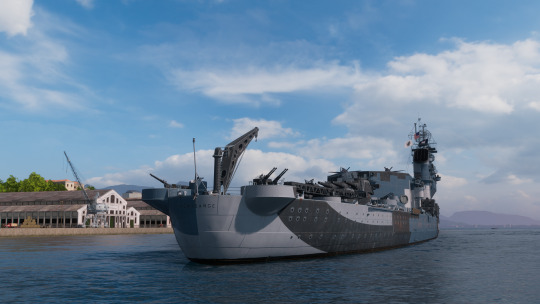
USS Kearsarge
How does all of this relate to Azur Lane and why her design is so angel-like?
The way I interpret the game mechanics and lore we know, is that PRs are from another universe entirely. My interpretation is that we don't get the other universe's version of, say, Chkalov; but an interpretation of her.
This is my headcanon: Kearsarge, in her original reality, is an attempt at creating an angel. I suspect she comes from either Anchorage's reality (based on how similar their design philosophies are, as if Anchorage were a little cherub, explaining her infant-like personality), or the reality we visit in Yorktown's II event. Maybe they are the same. Maybe one of the realities is an alternate universe of the other one, making them related.

Kearsarge has a sort of halo device that acts as a sort of physical interface between her and her rigging. She is literally hooked up to her halo, and her halo is in turn connected to her own rigging.
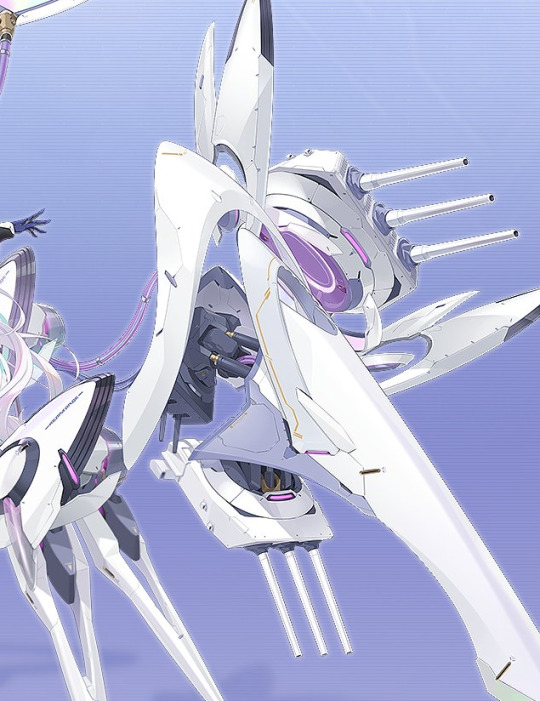
Her rigging, while only having two 'wings', is designed in such a way to appear as if she has more than two wings. Like a seraph, she gives the impression of having six wings.
I don't really have a conclusion. This is reaching, but this is what brainrot does to you.
--
--
Anyway. I want Kearsarge right fucking now.
#azur lane#priority research#uss kearsarge#new brainrot#holy shit she's so precious i can't contain my thoughts i have to share them with y'all
73 notes
·
View notes
Text







A Legacy
It is in the heart of the first United States naval base on the Pacific Ocean and it stands on the same foundation as the original commandant’s mansion. The first mansion was the home of one of the most famous naval officers in US history, Admiral David Glasgow Farragut, and it was destroyed in the Mare Island earthquake of 1898. Today’s mansion still stands on that original foundation, but much has changed from the days when that first mansion was constructed in the 1850’s. The mansion has transitioned from outdoor to indoor plumbing, oil lamps to electric lighting, carriage houses to garages etc. Of course, most of those changes were the result of the labors of public works employees or contractors, but the 10,340 bricks that constitute the walkways that meander through the spacious gardens were the work of one man who happened to command the naval base.
Vice Admiral Lowry was a man of small stature, but he was also a highly decorated naval officer who saw service in both World Wars. He was awarded the Navy Cross for extraordinary heroism and distinguished service as Commanding Officer of the Heavy Cruiser USS Minneapolis (CA-36), during operations at the battle of the Coral Sea only 5 months after the Japanese attack on Pearl Harbor. Following that attack Japanese forces had been rolling nearly unopposed across the Pacific. Then on 7 and 8 May 1942 his ship inflicted considerable damage on the Japanese and rendered vital protection to the US aircraft carrier USS Lexington to which it was assigned. The Battle of the Coral Sea was important as it was the first pure carrier-versus-carrier battle in history as neither surface fleet sighted the other. Though a draw, it was an important turning point in the war in the Pacific because, for the first time, the Allies had stopped the Japanese advance and lines of communication to Australia and New Zealand were kept open.
Admiral Lowry later commanded the invasions on the other side of the world at Salerno and Anzio (Italy). Lowry's Task Force 81 contained over 250 combat-loaded vessels and amphibious assault craft of all sizes and descriptions. Admiral Lowry also commanded the 74 vessels of Task Force X-Ray, assigned to see American forces safely ashore and to support their beachhead operations at Anzio. With the war ended, Admiral Lowry was soon put in command of Mare Island Naval Shipyard where he indulged one of his great passions, gardening. Admiral Lowry commanded Mare Island for 2 ½ years from 1947 to 1950 and during that time he constructed all the brick pathways that interlace the gardens behind the mansion.
Dennis Kelly
#mare island#naval history#san francisco bay#us navy#vallejo#san francisco#world war 2#world war ii#world war two#Adm Lowry#Coral Sea#Salerno#Anzio#USS Minneapolis
7 notes
·
View notes
Text

Launched in 1923, the S-44 was one of few “old pigboats” that saw extensive service in WW2 when the US Navy was desperate for Submarines after the onset of Pearl Harbor.
Serving on such boats took extra courage! I find these boats unique in that they were not the more well-known modern Gato or Balao-class boats,
but already had 20 years of service behind them when asked again to serve their country in time of war!.
With the leaks and deficiencies in these older submarines
(e.g., limited depth, speed,
no rear tubes,
and range capability), these boats still nonetheless served with distinction in WW2. S-44 earned two battle stars and has the distinction of being the first US Submarine in WW2 to sink an enemy cruiser -
that of the IJN heavy cruiser Kako in 1942 during the Battle of Savo Island!
But she was also tragically, the only S-Class boat to be lost to enemy action when she was sunk on 7 October 1943, as a result of surface gunfire with the Japanese Destroyer Escort Ishigaki off the Kuril Islands.
She was lost with only 2 survivors out of a complement of 38 crew (Lt.Cdr. Francis Elwood Brown went down with the ship).
Given this unique history, I wanted to build this boat!
I originally wanted to build the resin 1/350 S-Class model by Blue Water Navy but,
found it is very rare (if anyone has one, I am still interested as I collect 1/350 USN WW2 submarines).
With no luck in getting the 1/350 BWN model,
I decided to scratch-build one in 1/72. Given I had more time than usual with Covid19,
I started this project only in June 2020 and expect to finish in a month or so –
a record for my scratch-built projects which can last about a year minimum.
Here are pictures of the model in-progress thus far. It is not yet finished as I STILL have to add the many rivets found on these old boats!!!
The model was based on an old vacuform kit of a generic S-Class boat by the now defunct Combat Models.
However I found the old vacuform kit),
was not accurate in shape nor detailed enough as a start.
So far, the approach was to use the Combat Models as a guide to re vacuform the hull based on new plans I bought.
Methods included thermo forming,
along with styrene,
bass wood,
metal,
photo-etch,
resin casting,
and lots of gizmology parts from the spares box!
There is no major definitive book outlining the details of these old boats!
I relied solely on two grainy photos that exist of her as she exited Philadelphia Naval Shipyard in her last refit in summer 1943.
I also used photos of her near sisters (S-42 to S-46),
to guess at the rest of the details that could not be ascertained in those two old photos...
You will note that the boat had many details that are not symmetrical and aligned such as the flood holes (remember this boat was constructed in 1920!).
This is replicated on the model on purpose based on period photos of her flood hole arrangements.
While I thought a submarine would be relatively easy to scratch build,
I take that back as she has tons of little deck details.
The conning tower alone has about 150 parts itself.
In total, there will be about 400 parts to this “simple” sub.
It is not all scratch…the deck gun is from White Ensign Models
(but with more details added),
and the AA gun is from UM.
The S-44 was the only boat to mount this massive 4”/50 deck gun,
and her near sisters had the smaller 3” guns.
The paint scheme is of utmost challenge as she was simply “all black”.
I do not know how to go about it, but will tackle it one step at a time.
Thus the model represents S-44 after her final refit in June 1943,
and in what she might have looked at the time of her loss near Japan –
an old boat with a more modern conning tower!
This model is a tribute to all the crew on that boat, and those submariners still on “eternal patrol”.









I hope to contribute it and find a home for it one day at some naval museum.
More Pics on FB - Harvey Low
10 notes
·
View notes
Photo

Japanese Navy Heavy Cruiser "Takao" by Vlad Averi via ImaginaryWarships
18 notes
·
View notes
Text
I have been playing Azur lane for a while and have been noticing a sad trend in the new ships. In recent events they have been creeping more and more into really obscure ships that really didn’t do anything major irl, while they are ignoring extremely interesting and important ships from WWII.
I have, for a long while now, been hoping that they add some of the members of Taffy 3. Most specifically USS Johnston and USS Samuel B. Roberts.

Johnston in port
USS Johnston, when IJN Yamato and her escorts first engaged the small task force, provided smoke cover for the retreating CVEs. The ship broke off from the force much earlier than any others, and faced the enemy head on, forcing one heavy crusader, IJN Kunamo, to be scuttled later on. Johnston would score a couple hundred hits with her 5 inch guns, before being sunk, (reported as a cruiser by the Japanese). She would receive 6 battle stars, her captain was posthumously awarded the Medal of Honor, and Yukikaze saluted her as she sunk.

Samuel B. Roberts under way
Later in the engagement, the escort destroyer USS Samuel B. Roberts would earn herself one of the coolest titles ever. Once the carriers were somewhat safe in a rain squall, the rest of the destroyer escort was ordered to commence torpedo runs on their pursuers. The Roberts would assist in this task, and would end up expending the entirety of her ammunition before finally being sunk. She would receive a single battle star, with one of her gunners earning a posthumous silver star. She would also earn the title of “The escort destroyer that fought like a battleship” for her actions.
Both of these ships are extremely cool, and they prevented the complete destruction of American landing points on Samar. But they are completely ignored for ships as far back as WWI.
3 notes
·
View notes
Text
There's a bizarre kind of sweetness to Girls und Panzer that makes me think someone started the project on a whim and then went "nonono I'm SERIOUS" only to find the concept wasn't lending itself to seriousness without a LOT of mental gymnastics.
Like. You can tell, up front, that basically this anime was written by somebody that just really, really loved tanks. All the tanks. Big tanks, little tanks. All the tanks. And they had the not-too-weird thought of "well, girls and guns is hot. And girls and motorbikes is hot. So, if I put cute teenage girls in tanks, that's gotta be hot too, right?"
And as far as that goes, he wasn't wrong. But then, poor ideas-guy, they started trying to make that make sense. So there's whole bits about how the WHOLE COUNTRY loves tankery. There's tankery shops, and tankery cafes, and whole naval cruisers set aside for tankery battles. And the advertisements are all about how tankery is a 'feminine art' and will make women more beautiful and desirable and so on.
At which point I started thinking "You're overthinking this, writer person. You prooobably should've just stuck with 'girls in tanks = hot'."
And then...the Traditional Japanese Girl mindset met 'tank' and you can just see the worldbuilding collapsing. The tanks are too loud! The seats are uncomfortable! The paint scheme is drab! Cleaning tanks gets you sweaty and dirty! ...All of which kinda flies in the face of Tankery being seen as a 'feminine art', because if this world as set up REALLY THOUGHT THAT, the girls wouldn't be having those reactions.
They certainly wouldn't be having the reactions of 'let's paint our tank red and reflective gold and cover it with flags', or 'paint it pink', or 'decorate it with delicate lacy curtains and soft cushions and cute stickers'.
Please note that I am not saying tanks can't be (or aren't) feminine. Or that 'driving a tank' is somehow not feminine. I am saying that the worldbuilding of the anime is trying to have it both ways, by saying tanks as we know them are inherently feminine while at the same time having every girl in the setting who isn't raised in the art finding it unpleasant and uncomfortable and in need of ...well, what Japanese culture tends to think of as 'feminine touches'. If Tankery in this setting really IS a 'feminine art', then the tanks would either ALREADY LOOK LIKE THAT, or the girls would be just fine with them as they are.
(Much like we don't bat an eye at 'horse girls', who are just fine with mucking out stalls and other 'heavy/unpleasant work' related to horses, yet they aren't seen as less 'girl' for this - on the contrary it's often seen as a perfectly normal thing.)
....I do love that they're making a distinction between 'tankery' and 'warfare'. It feels kind of like the distinction between 'fencing' and 'actually trying to kill an opponent with a sword' at times, but it's intriguing.
That said, I may have to rewatch this series a few times because the pieces don't mesh together quite right and that tends to make me want to write fanfic. (I mean Our Heroine STARTED THE SERIES WITH IDENTIFIABLE PTSD WHY IS NOBODY TALKING ABOUT IT.)
4 notes
·
View notes
Text

IJN Maya, Heavy Cruiser.
5 notes
·
View notes
Text
I like this a lot, especially the inclusion of Tolkien as translator! :->
However, IMO it shouldn't be set during the Blitz but at the height of the Battle of Britain, and a good day for it might be September 15th 1940.
That was the day when Churchill, visiting a fighter control station during the height of massive raids, was told that every single RAF aircraft from 11 Group (defending London and the south-east) was in action. Churchill asked, "What about reserves?" and got a simple answer:
"We have none..."
*****
The 1969 film "Battle of Britain" did it like this. No CGI here, just practical effects, model aircraft and real ones (enough real ones to be the 35th largest air force in the world...)
youtube
*****
To enlarge a bit, the Blitz - while protracted and unpleasant - wasn't Britain's darkest hour.
That more likely came in 1942 with a string of retreats and defeats, including a couple where superior British forces surrendered to a much smaller enemy and one piece of amazing audacity.
Japanese victories in Asia, including the fall of Singapore;
Axis victories in North Africa, including the fall of Tobruk,
Operation Cerberus, the "Channel Dash", when two German battleships, a heavy cruiser and all their escort vessels sailed from France to Germany in broad daylight through the Straits of Dover.
An extraordinary sequence of misfortunes (bad weather, faulty radar) and cock-ups (over-strict radio silence, wrong ammunition) meant British Channel defences were - in a period phrase - "caught with both pairs of trousers at the cleaners", and caused virtually no damage to the enemy ships despite them being right on Britain's doorstep.
(Both German battleships were damaged by mines before they got home, but that wasn't a result of deliberate attacks. All of those were failures. Lots more information here.)
Cerberus wasn't as strategically damaging as Dunkirk, Singapore, Tobruk and too many others, but the impudence and success of it left a lot of egg on a lot of faces.
I have a very rough idea in my head that I don't think I can clearly articulate beyond "And that concludes tonight's reports on German air forc—WHAT'S THIS? IT'S KING ARTHUR WITH A STEEL CHAIR"
#arms and armour#military history#WWII#Second World War#King Arthur#story seed#Battle of Britain#Operation Cerberus#Youtube
39K notes
·
View notes
Text
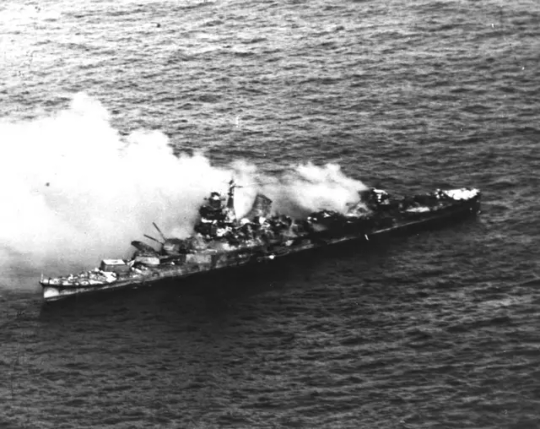
Japanese heavy cruiser Mikuma burning after being bombed by USS Enterprise's aircraft during the Battle of Midway, 6 June 1942
33 notes
·
View notes
Text
Events 4.9 (before 1950)
193 – The distinguished soldier Septimius Severus is proclaimed emperor by the army in Illyricum. 475 – Byzantine Emperor Basiliscus issues a circular letter (Enkyklikon) to the bishops of his empire, supporting the Monophysite christological position. 537 – Siege of Rome: The Byzantine general Belisarius receives his promised reinforcements, 1,600 cavalry, mostly of Hunnic or Slavic origin and expert bowmen. He starts, despite shortages, raids against the Gothic camps and Vitiges but is forced into a stalemate. 1241 – Battle of Liegnitz: Mongol forces defeat the Polish and German armies. 1288 – Mongol invasions of Vietnam: Yuan forces are defeated by Trần forces in the Battle of Bach Dang in present-day northern Vietnam. 1388 – Despite being outnumbered 16:1, forces of the Old Swiss Confederacy are victorious over the Archduchy of Austria in the Battle of Näfels. 1454 – The Treaty of Lodi is signed, establishing a balance of power among northern Italian city-states for almost 50 years. 1609 – Eighty Years' War: Spain and the Dutch Republic sign the Treaty of Antwerp to initiate twelve years of truce. 1609 – Philip III of Spain issues the decree of the "Expulsion of the Moriscos". 1682 – Robert Cavelier de La Salle discovers the mouth of the Mississippi River, claims it for France and names it Louisiana. 1784 – The Treaty of Paris, ratified by the United States Congress on January 14, 1784, is ratified by King George III of the Kingdom of Great Britain, ending the American Revolutionary War. Copies of the ratified documents are exchanged on May 12, 1784. 1860 – On his phonautograph machine, Édouard-Léon Scott de Martinville makes the first known recording of an audible human voice. 1865 – American Civil War: Robert E. Lee surrenders the Army of Northern Virginia (26,765 troops) to Ulysses S. Grant at Appomattox Court House, Virginia, effectively ending the war. 1909 – The U.S. Congress passes the Payne–Aldrich Tariff Act. 1917 – World War I: The Battle of Arras: The battle begins with Canadian Corps executing a massive assault on Vimy Ridge. 1918 – World War I: The Battle of the Lys: The Portuguese Expeditionary Corps is crushed by the German forces during what is called the Spring Offensive on the Belgian region of Flanders. 1937 – The Kamikaze arrives at Croydon Airport in London. It is the first Japanese-built aircraft to fly to Europe. 1939 – African-American singer Marian Anderson gives a concert at the Lincoln Memorial after being denied the use of Constitution Hall by the Daughters of the American Revolution. 1940 – World War II: Operation Weserübung: Germany invades Denmark and Norway. 1940 – Vidkun Quisling seizes power in Norway. 1942 – World War II: The Battle of Bataan ends. An Indian Ocean raid by Japan's 1st Air Fleet sinks the British aircraft carrier HMS Hermes and the Australian destroyer HMAS Vampire. 1945 – Dietrich Bonhoeffer, Lutheran pastor and anti-Nazi dissident, is executed by the Nazi regime. 1945 – World War II: The German heavy cruiser Admiral Scheer is sunk by the Royal Air Force. 1945 – World War II: The Battle of Königsberg, in East Prussia, ends. 1945 – The United States Atomic Energy Commission is formed. 1947 – The Glazier–Higgins–Woodward tornadoes kill 181 and injure 970 in Texas, Oklahoma, and Kansas. 1947 – The Journey of Reconciliation, the first interracial Freedom Ride begins through the upper South in violation of Jim Crow laws. The riders wanted enforcement of the United States Supreme Court's 1946 Irene Morgan decision that banned racial segregation in interstate travel. 1947 – United Nations Security Council Resolution 22 relating to Corfu Channel incident is adopted. 1948 – Jorge Eliécer Gaitán's assassination provokes a violent riot in Bogotá (the Bogotazo), and a further ten years of violence in Colombia. 1948 – Fighters from the Irgun and Lehi Zionist terror groups attacked Deir Yassin near Jerusalem, killing over 100 Palestinians.
0 notes